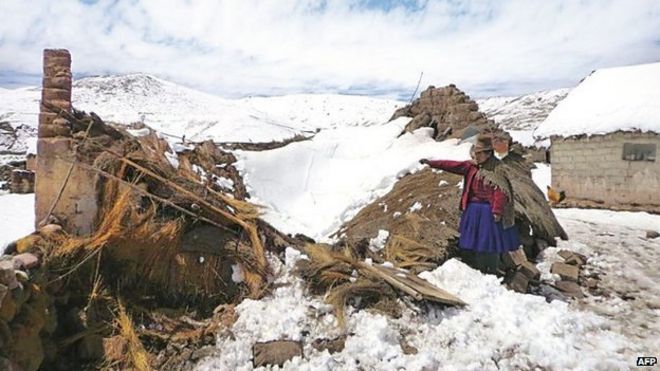|
By Dan Collyns
BBC News, Macusani, Peru
|
For centuries, the alpaca has sustained the indigenous people of the Andean highlands in Peru, Bolivia and northern Chile.
The animal has become a symbol of this snow-capped region, but farmers
in Peru are concerned that wool quality is declining and fear that the
genetic pool of the world's largest alpaca industry may deteriorate
dramatically.
They are also concerned about increasing competition from countries like
Australia and New Zealand, which, thanks to more advanced technology
and greater resources, have enjoyed great success in their alpaca
breeding programmes.
But now, with funding from the French Embassy in Peru and the British
charity Oxfam, a programme has begun to help the genetic improvement of
alpacas in the southern region of Puno - one of the poorest parts of the
country and home to 1.6 million alpacas.
Ideal habitat
The town of Macusani, in Puno, prides itself on being the alpaca capital of the world.
At 4,700 metres (15,400 feet) above sea level, the air is thin and
freezing, the sun fierce and the earth supports little but sparse tufts
of yellowing grass.
But while little flourishes in this harsh landscape, it is the ideal
habitat for llamas, and their smaller, woollier cousins, the alpacas.

Alpaca wool is warmer than sheep's - and much lighter
|
The people in Macusani seem to adore the creature.
Its ample, thick wool provides them with the warmth that's vital in the
cold highlands of the Andean Carabaya Cordillera, where many people live
in huts made out of adobe mud bricks or stones.
Its gamey meat is a valuable source of protein and its docile nature makes it easy to domesticate.
But there is also great international demand for alpaca wool as a luxury
product - it's extremely warm, lighter than sheep's wool and softer to
the touch.
National forum
Miles away from Macusani, a cluster of stone dwellings perch on the side
of a valley. All around it a herd of placid llamas and alpacas graze on
the thin grass.
Here Miguel Cano, 79, and his wife Micaela, have raised 14 children and thousands of alpacas in the last 50 years.
With no help from the state or local government until now, he put his
children through school and university on the proceeds of alpaca
farming.
His daughter, Teodora Cano, is president of the regional branch of the Peruvian Society of Llama and Alpaca Breeders (Spar).
"We owe everything to the alpaca. Now we have a national forum we can
ensure that all alpaca farmers are paid a fair price for their wool,"
she says.
"Anything which improves the quality of the wool will help alpaca farmers."
Mountain laboratory
Zenon Choquehuanca, the director of the alpaca genetic improvement
project, wants to redress what he sees as the unfair advantage more
developed countries have in their breeding programmes.
"Australia and other countries which breed alpacas bought in Peru have
used the highest technology for their genetic improvement", he said.
"It's our aim to do the same here in Peru."
Mr Choquehuanca explains that an alpaca's fleece is judged by two criteria - volume and fineness.
Now using the new technology they can measure the number of hair
follicles per square centimetre as well as the diameter of the
individual hairs - the finer the hairs, the better the wool.
Located in isolated mountain splendour is the Munay Paq'ocha laboratory -
the name means "beautiful alpaca" in the indigenous Quechua language.
Alpaca wool is washed and heated in a stove before the fat in each hair
is measured to assess the elasticity of the fibre. The fibres are then
weighed.
Using a microscope the diameter of fibres is measured - the thinner the fibres the better the wool.
This information is cross-referenced with the birth date and birth
weight of the alpacas and enables those with the optimum characteristics
to be bred together.
"As they see their lives improve through the science applied to their
farming practices the alpaca farmers will learn so they can effectively
improve their breeding stock," he says.
Alpaca breeder Temistocles Riquelme Ardiles attests to the alpaca's greatness.
Wearing a woollen poncho he stands in the freezing winds among hundreds
of Suris - a variety of alpaca - on the bare plains near his home.
"I love the Alpaca like a beautiful woman, she gives me warmth and
comfort, food and a bed - she gives me everything," he says as he grabs
one of the alpacas around the neck and kisses it firmly.
The mayor of Carabaya region, Michel Portier - a Frenchman who has lived
in Peru for 18 years - has secured the financial backing to establish
the programme.
"The genetic selection of alpacas directly affects the quality of life
of the people who live here and helps the fight against poverty," he
says.
"Agriculture is a risky business at this altitude - some years we have such a cold frost that it can kill a whole crop.
"The only reliable resource the people have here is the alpaca."
















